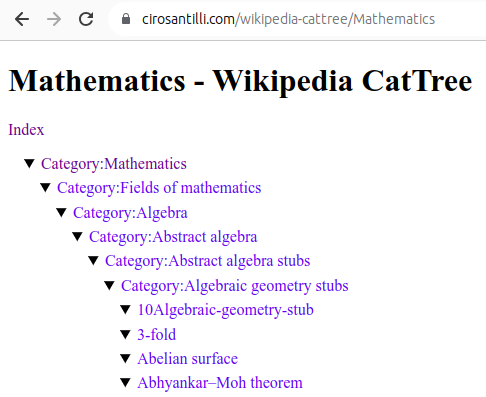Vector graphics Updated 2025-07-16
Hermitian form Updated 2025-07-16
The prototypical example of it is the complex dot product.
Note that this form is neither strictly symmetric, it satisfies:where the over bar indicates the complex conjugate, nor is it linear for complex scalar multiplication on the second argument.
Bibliography:
Higgs boson Updated 2025-07-16
High-temperature superconductivity Updated 2025-07-16
As of 2020, basically means "liquid nitrogen temperature", which is much cheaper than liquid helium.
The dream of course being room temperature and pressure superconductor.
Wikipedia Updated 2025-07-16
Why Wikipedia sucks: Section "Wikipedia".
Best languages:
The most important page of Wikipedia is undoubtedly: en.wikipedia.org/wiki/Wikipedia:Reliable_sources/Perennial_sources which lists the accepted and non accepted sources. Basically, the decision of what is true in this world.
Wikipedia is incredibly picky about copyright. E.g.: en.wikipedia.org/wiki/Wikipedia:Deletion_of_all_fair_use_images_of_living_people because "such portrait could be created". Yes, with a time machine, no problem! This does more harm than good... excessive!
Citing in Wikipedia is painful. Partly because of they have a billion different templates that you have to navigate. They should really have a system where you can easily reuse existing sources across articles! Section "How to use a single source multiple times in a Wikipedia article?"
- youtu.be/_Rt0eAPLDkM?t=113 encyclopedia correction stickers. OMG!
- youtu.be/_Rt0eAPLDkM?t=201 Jimmy was a moderator on MUD games
Inside the Wikimedia Foundation offices by Wikimedia Foundation (2008)
Source. Wikipedia analytics Updated 2025-07-16
Mark 17 nuclear bomb Updated 2025-07-16
Mathieu group Updated 2025-07-16
Contains the first sporadic groups discovered by far: 11 and 12 in 1861, and 22, 23 and 24 in 1973. And therefore presumably the simplest! The next sporadic ones discovered were the Janko groups, only in 1965!
Each is a permutation group on elements. There isn't an obvious algorithmic relationship between and the actual group.
TODO initial motivation? Why did Mathieu care about k-transitive groups?
Their; k-transitive group properties seem to be the main characterization, according to Wikipedia:
Looking at the classification of k-transitive groups we see that the Mathieu groups are the only families of 4 and 5 transitive groups other than symmetric groups and alternating groups. 3-transitive is not as nice, so let's just say it is the stabilizer of and be done with it.
Mathieu group section of Why Do Sporadic Groups Exist? by Another Roof (2023)
. Source. Only discusses Mathieu group but is very good at that. The Principles of Quantum Mechanics by Paul Dirac (1930) Updated 2025-07-16
Wikipedia CatTree Updated 2025-07-16
This mini-project walks the category hierarchy Wikipedia dumps and dumps them in various simple formats, HTML being the most interesting!
Wikipedia dumps Updated 2025-07-16
Per-table dumps created with mysqldump and listed at: dumps.wikimedia.org/. Most notably, for the English Wikipedia: dumps.wikimedia.org/enwiki/latest/
A few of the files are not actual tables but derived data, notably dumps.wikimedia.org/enwiki/latest/enwiki-latest-all-titles-in-ns0.gz from Download titles of all Wikipedia articles
The tables are "documented" under: www.mediawiki.org/wiki/Manual:Database_layout, e.g. the central "page" table: www.mediawiki.org/wiki/Manual:Page_table. But in many cases it is impossible to deduce what fields are from those docs.
Wiley (publisher) Updated 2025-07-16
William Shockley Updated 2025-07-16
Willis Lamb Updated 2025-07-16
Box2D Updated 2025-07-16
CIA 2010 covert communication websites Internet Census 2012 Updated 2025-07-16
Does not appear to have any reverse IP hits unfortunately: opendata.stackexchange.com/questions/1951/dataset-of-domain-names/21077#21077. Likely only has domains that were explicitly advertised.
We could not find anything useful in it so far, but there is great potential to use this tool to find new IP ranges based on properties of existing IP ranges. Part of the problem is that the dataset is huge, and is split by top 256 bytes. But it would be reasonable to at least explore ranges with pre-existing known hits...
We have started looking for patterns on
66.* and 208.*, both selected as two relatively far away ranges that have a number of pre-existing hits. 208 should likely have been 212 considering later finds that put several ranges in 212.tcpip_fp:
- 66.104.
- 66.104.175.41: grubbersworldrugbynews.com: 1346397300 SCAN(V=6.01%E=4%D=1/12%OT=22%CT=443%CU=%PV=N%G=N%TM=387CAB9E%P=mipsel-openwrt-linux-gnu),ECN(R=N),T1(R=N),T2(R=N),T3(R=N),T4(R=N),T5(R=N),T6(R=N),T7(R=N),U1(R=N),IE(R=N)
- 66.104.175.48: worlddispatch.net: 1346816700 SCAN(V=6.01%E=4%D=1/2%OT=22%CT=443%CU=%PV=N%DC=I%G=N%TM=1D5EA%P=mipsel-openwrt-linux-gnu),SEQ(SP=F8%GCD=3%ISR=109%TI=Z%TS=A),ECN(R=N),T1(R=Y%DF=Y%TG=40%S=O%A=S+%F=AS%RD=0%Q=),T1(R=N),T2(R=N),T3(R=N),T4(R=N),T5(R=Y%DF=Y%TG=40%W=0%S=Z%A=S+%F=AR%O=%RD=0%Q=),T6(R=N),T7(R=N),U1(R=N),IE(R=N)
- 66.104.175.49: webworldsports.com: 1346692500 SCAN(V=6.01%E=4%D=9/3%OT=22%CT=443%CU=%PV=N%DC=I%G=N%TM=5044E96E%P=mipsel-openwrt-linux-gnu),SEQ(SP=105%GCD=1%ISR=108%TI=Z%TS=A),OPS(O1=M550ST11NW6%O2=M550ST11NW6%O3=M550NNT11NW6%O4=M550ST11NW6%O5=M550ST11NW6%O6=M550ST11),WIN(W1=1510%W2=1510%W3=1510%W4=1510%W5=1510%W6=1510),ECN(R=N),T1(R=Y%DF=Y%TG=40%S=O%A=S+%F=AS%RD=0%Q=),T1(R=N),T2(R=N),T3(R=N),T4(R=N),T5(R=Y%DF=Y%TG=40%W=0%S=Z%A=S+%F=AR%O=%RD=0%Q=),T6(R=N),T7(R=N),U1(R=N),IE(R=N)
- 66.104.175.50: fly-bybirdies.com: 1346822100 SCAN(V=6.01%E=4%D=1/1%OT=22%CT=443%CU=%PV=N%DC=I%G=N%TM=14655%P=mipsel-openwrt-linux-gnu),SEQ(TI=Z%TS=A),ECN(R=N),T1(R=Y%DF=Y%TG=40%S=O%A=S+%F=AS%RD=0%Q=),T1(R=N),T2(R=N),T3(R=N),T4(R=N),T5(R=Y%DF=Y%TG=40%W=0%S=Z%A=S+%F=AR%O=%RD=0%Q=),T6(R=N),T7(R=N),U1(R=N),IE(R=N)
- 66.104.175.53: info-ology.net: 1346712300 SCAN(V=6.01%E=4%D=9/4%OT=22%CT=443%CU=%PV=N%DC=I%G=N%TM=50453230%P=mipsel-openwrt-linux-gnu),SEQ(SP=FB%GCD=1%ISR=FF%TI=Z%TS=A),ECN(R=N),T1(R=Y%DF=Y%TG=40%S=O%A=S+%F=AS%RD=0%Q=),T1(R=N),T2(R=N),T3(R=N),T4(R=N),T5(R=Y%DF=Y%TG=40%W=0%S=Z%A=S+%F=AR%O=%RD=0%Q=),T6(R=N),T7(R=N),U1(R=N),IE(R=N)
- 66.175.106
- 66.175.106.150: noticiasmusica.net: 1340077500 SCAN(V=5.51%D=1/3%OT=22%CT=443%CU=%PV=N%G=N%TM=38707542%P=mipsel-openwrt-linux-gnu),ECN(R=N),T1(R=N),T2(R=N),T3(R=N),T4(R=N),T5(R=Y%DF=Y%TG=40%W=0%S=Z%A=S+%F=AR%O=%RD=0%Q=),T6(R=N),T7(R=N),U1(R=N),IE(R=N)
- 66.175.106.155: atomworldnews.com: 1345562100 SCAN(V=5.51%D=8/21%OT=22%CT=443%CU=%PV=N%DC=I%G=N%TM=5033A5F2%P=mips-openwrt-linux-gnu),SEQ(SP=FB%GCD=1%ISR=FC%TI=Z%TS=A),ECN(R=Y%DF=Y%TG=40%W=1540%O=M550NNSNW6%CC=N%Q=),T1(R=Y%DF=Y%TG=40%S=O%A=S+%F=AS%RD=0%Q=),T2(R=N),T3(R=N),T4(R=N),T5(R=Y%DF=Y%TG=40%W=0%S=Z%A=S+%F=AR%O=%RD=0%Q=),T6(R=N),T7(R=N),U1(R=N),IE(R=N)
XPath Updated 2025-07-16
E. Coli K-12 MG1655 gene thrB Updated 2025-07-16
Immediately follows e. Coli K-12 MG1655 gene thrA,
Part of E. Coli K-12 MG1655 operon thrLABC.
House mouse Updated 2025-07-16
Quantum compiler benchmark Updated 2025-07-16
These appear to be benchmarks that don't involve running anything concretely, just compiling and likely then counting gates:
There are unlisted articles, also show them or only show them.


